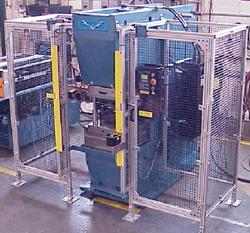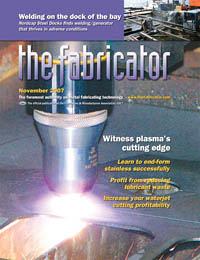- FMA
- The Fabricator
- FABTECH
- Canadian Metalworking
Categories
- Additive Manufacturing
- Aluminum Welding
- Arc Welding
- Assembly and Joining
- Automation and Robotics
- Bending and Forming
- Consumables
- Cutting and Weld Prep
- Electric Vehicles
- En Español
- Finishing
- Hydroforming
- Laser Cutting
- Laser Welding
- Machining
- Manufacturing Software
- Materials Handling
- Metals/Materials
- Oxyfuel Cutting
- Plasma Cutting
- Power Tools
- Punching and Other Holemaking
- Roll Forming
- Safety
- Sawing
- Shearing
- Shop Management
- Testing and Measuring
- Tube and Pipe Fabrication
- Tube and Pipe Production
- Waterjet Cutting
Industry Directory
Webcasts
Podcasts
FAB 40
Advertise
Subscribe
Account Login
Search
End forming stainless steels
Success depends on analyzing the workpiece, tooling, and machine design
- By Herb Friedrich
- November 6, 2007
- Article
- Tube and Pipe Fabrication
Charger®. Mustang®. Camaro®. Challenger®. Barracuda®. Regardless of which muscle car is your favorite, they all share a few characteristics. Masculine designs. Distinctive paint jobs. Sporty, racing-style interiors and accessories. And much more horsepower than you need to go get some groceries or run the kids to soccer practice.
Muscle cars ruled the streets a few decades ago, and many of them are back. The unsung heroes then, as always, were the exhaust systems. A well-designed exhaust system adds to the car's aesthetic appeal; enhances performance; and gives it a distinctive, signature sound. Forget about manifolds, pipes, and mufflers. The key to developing a deep, throaty roar is designing and manufacturing a good resonator. As the word resonator implies, this component's job is to develop frequencies that resonate—that is, strengthen and boost the sound developed by the engine and other exhaust components. A muscle car should do more than go fast and look good. A muscle car should sound great too.
Single-piece tubular resonators made from 409 stainless steel, which are becoming increasingly popular, can present a unique challenge. Complicating matters is a resonator design that requires stuffing them with internal components before they undergo any end forming operations.
Analyzing every factor—the workpiece alloy, the ram tool material, the tool design, and the machine design—can go a long way in ensuring that the process turns the raw material into a successfully formed resonator.
Reducing Challenges
Reducing stainless steel tube can be difficult, especially when the tube ends must be reduced by a large amount from the parent diameter. The characteristics of the alloy, the quality of the weld, and the properties of the heat-affected zone (HAZ) all factor into how much the tube can be reduced under production conditions.
The most common failure in the reduction process relates to the weld seam. Either the weld seam folds into the inside diameter of the tube during the reduction process or the weld seam shows signs of cracking. This is because, during the reduction process, the parent material and the weld seam elongate at different rates.
Fabricators might find that 409's characteristics vary significantly from one supplier to the next, often enough that the tube from one source reduces significantly better than tube from another source. The lesson? Don't be afraid to experiment with materials from different suppliers.
The material is only one factor in the process. The ram reduction tools are equally important. Successful end forming requires paying careful attention to many tooling design factors, including the transition angle (the angle between the starting tube diameter and the target diameter for the particular operation), the material the tool is made from, heat treatment, surface finish, and the tool surface coating.
Other factors that affect the forming process are the equipment's rigidity and lubrication.
Ram Tool Design
The design of a ram tool for a specific application is relatively straightforward. For stainless steel, at least 70 percent of the total reduction has to be formed in the first operation. The transition angle must not be too steep or too shallow. A too-steep angle results in either tube column failure (the tube collapses) or a stalled forming operation (because the machine does not have enough force to complete the stroke). A too-shallow angle can lead to difficulty in stripping the reduced tube from the ram. The tube and the ram tool can become locked together.

This exhaust application requires a machine with an opening large enough to accommodate a two-cavity clamp for forming two tube ends simultaneously. Other machine requirements include easy access for manual loading and unloading; sufficient tonnage for clamping the tube; and enough space for a multistation shuttle head.
The transition angles of the resonator design are the starting point for the tool design. If the initial design doesn't form the specified or supplied tube successfully, the tooling designer must develop a design that does work.
A recommended material for an application such as this is D2 hardened to 59-60 Rockwell C. Applying a thermal diffusion (TD) coating and polishing the tooling provide a low coefficient of friction that improves material flow, increases tool life, and reduces galling.
Manufacturing a ram from tool steel is acceptable for part trials and preproduction part runs to ensure the finished sizes and forms produced from the tooling are acceptable. For high-volume production, parts that require high forming pressures, or for parts that cannot use a flood-type lubricant, carbide tooling is recommended because it holds up much better under difficult forming conditions. Carbide tooling is made only after the tool steel tooling has been developed and proven.
For this exhaust project, the resonator had an internal tube wrapped with fiber-type insulation, so a flood-type lubricant could not be used. In addition, it was a high-volume application.
An alternate lubrication method, swabbing the outsides of the tube ends with a lubricant, was used to aid the forming process. The tool geometry was developed with tool steel made from carbide recommended for the final production tools.
Machine Design
The type and size of the forming machine recommended for an application depend on the production volume, tube size, the number of operations required to form the part, the forces required to hold the part while forming, and the force required to form the part.
To achieve a good level of manufacturing productivity, the application discussed previously requires a machine with an opening large enough to accommodate a two-cavity clamp so that two tube ends can be formed simultaneously. Other machine requirements are easy access for manual loading and unloading; enough tonnage to clamp the tube; and the ability to fit it with a multistation shuttle head.
A typical ram forming machine does not meet these criteria—it lacks the necessary tonnage and cannot accommodate a multishuttle forming head. Instead, a C-frame machine would be suitable for this application.
This resonator requires three reduction operations to form the part to the point where the inner tube (with the insulation) and the reduced outer tube can be positioned and staked (locked) together in a secondary process. The machine has a four-station tool shuttle (one station to position the tubes in the vise cavities before clamping and three stations for the reduction operations). This tool shuttle would be large enough to hold the four tools for each of the two tube ends being formed. An additional feature in the dual-cavity vise jaw is a mechanism to free the clamped tubes from the vise cavity to allow the operator to remove them easily.
About the Author
Herb Friedrich
4 Edmondson St.
Brantford, ON N3R 7J3 Canada
519-756-5223
Related Companies
subscribe now

The Fabricator is North America's leading magazine for the metal forming and fabricating industry. The magazine delivers the news, technical articles, and case histories that enable fabricators to do their jobs more efficiently. The Fabricator has served the industry since 1970.
start your free subscription- Stay connected from anywhere

Easily access valuable industry resources now with full access to the digital edition of The Fabricator.

Easily access valuable industry resources now with full access to the digital edition of The Welder.

Easily access valuable industry resources now with full access to the digital edition of The Tube and Pipe Journal.
- Podcasting
- Podcast:
- The Fabricator Podcast
- Published:
- 04/16/2024
- Running Time:
- 63:29
In this episode of The Fabricator Podcast, Caleb Chamberlain, co-founder and CEO of OSH Cut, discusses his company’s...
- Trending Articles
How to set a press brake backgauge manually

Capturing, recording equipment inspection data for FMEA

Tips for creating sheet metal tubes with perforations

Are two heads better than one in fiber laser cutting?

Hypertherm Associates implements Rapyuta Robotics AMRs in warehouse

- Industry Events
16th Annual Safety Conference
- April 30 - May 1, 2024
- Elgin,
Pipe and Tube Conference
- May 21 - 22, 2024
- Omaha, NE
World-Class Roll Forming Workshop
- June 5 - 6, 2024
- Louisville, KY
Advanced Laser Application Workshop
- June 25 - 27, 2024
- Novi, MI



























